
I love a DNA test. I love finding out as much information about my body as I can. I want to understand how I work.
So when I got the opportunity to try out FitnessGenes – a product that can tell you what exactly you should be doing for exercise based on your DNA – I rushed to sign up.
For £149, you spit in a tube (or if you’ve done an AncestryDNA or 23andMe kit, you give them access to that data £69), post it off, and then wait six weeks for your profile to come back.
With over 150 reports into different aspects of your DNA, the findings are certainly comprehensive, but portioned out into understandable and accessible chunks.
You can delve into sections like, Biological Ageing, Sleep Health, Blood Sugar Levels. But the ones I was most keen to explore were Appetite Control, Muscle Building, Endurance and Heart Health.
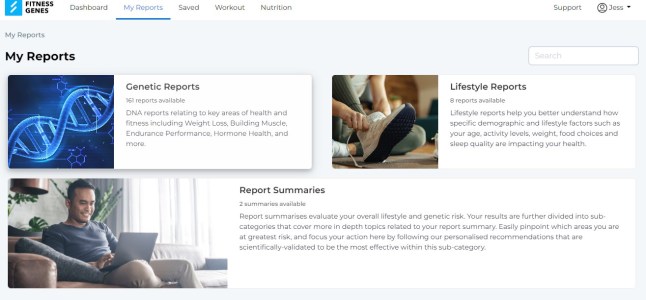
I’ve been going to the gym about four or five times a week for the past year with the aim of toning up and building muscle. I found my way in through spin and legs, bums and tums classes, before I started seeing a PT to help with weights, while going for a run once or twice a week.
As a result, I feel like my cardio has improved (but I struggle to go any further than 5k), and I can now lift more weight than I could before. Yay.
But on the whole I’m just trying everything to see what will help me meet my goals, without actually knowing if I’m going about it the right way at all.
I was curious whether FitnessGenes would be able to provide the answers. Would I finally find out if I’m meant to be a runner? Or perhaps a weight lifter? Could I let it determine my workouts forevermore?
Not exactly.

After speaking to the founders, Dr Samantha Decombel and Dr Stuart Grice, I learned that their product is not meant to promote one form of exercise over another – it’s there to help you achieve your fitness goals.
Through a two-pronged approach, firstly, you get an insight into what your genes are saying. Secondly, they offer advice about how to work with your genetic disposition to better your results.
Although the pair are very pro resistance – which uses weight or force to help work your muscles – to boost fitness levels into old age, they’re not there to discourage cardio-lovers.
If you like running but your genes aren’t working in your favour, Samantha and Stuart’s team have put together a host of tips to help you along your way.
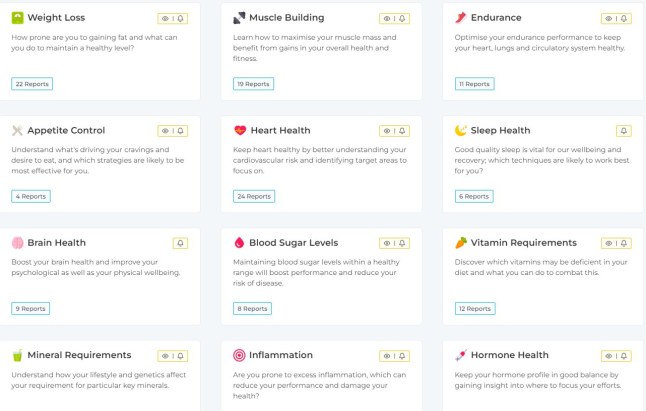
For example, when I click on the Endurance tab under the Genetic Reports banner, I can see all the aspects of my genes that work for and against me in this field (the latter are marked with a red tag).
One report into red blood cell production indicates that, like 19% of the population, I produce less, which means I’m likely to be worse at endurance sports as I’m less able to transport oxygen to exercising muscles.
I say likely, because even though I have the gene for it, it is not guaranteed.
I can read how certain gene variants (not the ones I have) are better for this type of exercise.
FitnessGenes then suggests what I can do to help my performance, including adding spirulina powder – a dietary supplement made from algae – to my smoothies (who knew it could increase haemoglobin mass?), and avoiding black tea before, during or an hour after eating a meal containing iron, which boosts oxygen transportation.
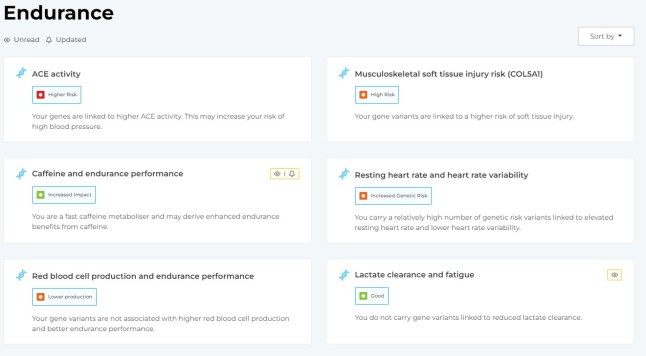
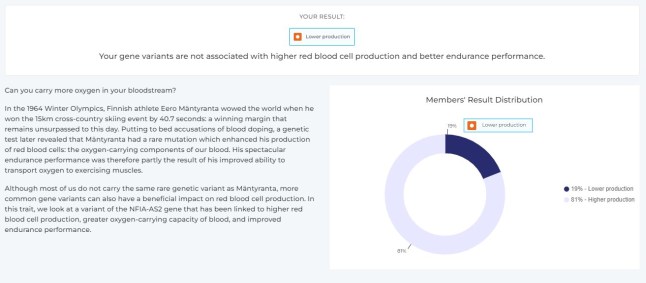
Similarly, in the Muscle Building tab, I find that I have gene variants that, while linked to lower body fat levels, lead to reduced muscle gains in response to resistance training (like 29% of people).
For this, it’s recommended that I add drop sets – where you decrease the weight but increase the reps every set, with little rest in between – into my resistance workouts, and take 5g of creatine post-exercise to help build the size of my muscles.
But it’s not all doom and gloom. It turns out I have a good post-exercise recovery rate and should be aiming for six sessions a week. It’s a lot, but I feel optimistic that I can achieve the changes I want to see.
I also learn that I respond well to caffeine right before a workout, as like 50% of people, it enhances my physical performance by stimulating my central nervous system.
I find out that my optimal rest period is 45-60 seconds between sets and I should aim for 12-15 reps each time.
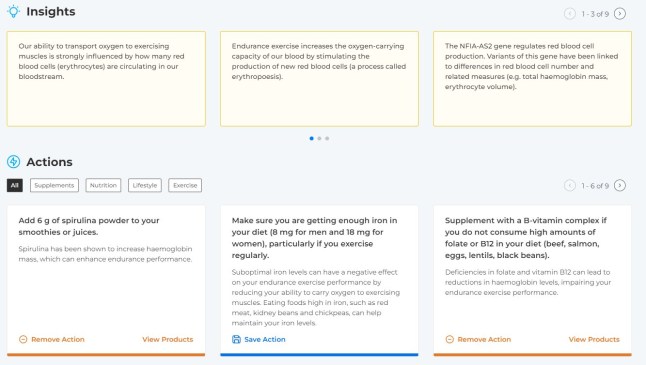
I’m most impressed by the Weight Loss report, which really sheds some light on my bad eating habits.
Turns out I carry genetic variants that come with an increased risk of impulsive eating, others that are associated with emotional eating, and some that impair fat taste sensitivity – meaning I likely eat more fat than others without feeling full.
To help with this, I should keep a mood/food journal, aim to eat one meal a day without distractions, and pause for five minutes when a craving strikes.
Each trait comes with a handful of tips, and while it would be impossible to action all of them, picking a couple is really achievable.
Since uncovering my results, I’ve been using food tracking apps, adding a scoop of protein powder to my porridge in the morning, and preparing healthy snacks, which has helped me avoid the Tunnock’s Tea Cakes in the office canteen.
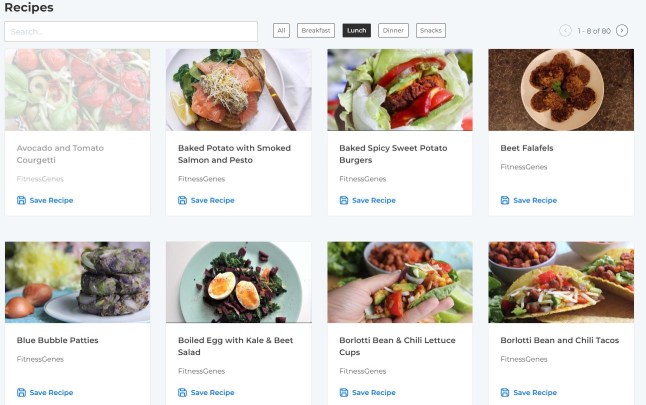
On top of the DNA findings, FitnessGenes also offers a selection of recipes to help complement your new healthy lifestyle, and offers workout plans for different goals (fitness, weight loss, getting lean, and building muscle), which can be purchased for between £23-£63 depending on the length of the plan.
I opted for the 12 week get lean plan, which is tailored to my DNA results. I’m not joking when I say it’s changed how I exercise.
Before, my routine was pretty much the same week on week – except for during my PT session. I used the same machines and did the same exercises, alternating between legs and arms every day, occasionally throwing in a run for good measure on top of my cycle commute.
It was fine, I was making progress, but I wasn’t really pushing myself.
This plan doesn’t tell you what weights to use, but it does tell you how many sets and reps, the tempo, how long you should be resting for – and every day is different.
I’ve never covered as much ground in the gym as I did on my first day – goblet squats, deadlifts, Bulgarian lunges, leg extensions, Russian twists, and that’s just half of it.
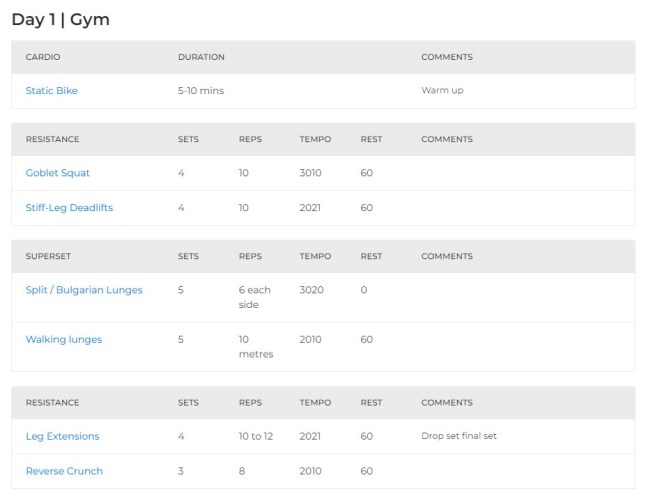
The next day (with sore legs) I did arms, Wednesday was HIIT, Thursday used different parts of the arms, Friday was circuits, before rounding out the week with cardio.
And the next week, everything was completely new. I love that the plan keeps things exciting.
The only drawback is that for those unfamiliar with certain exercises, it could be a little intimidating, but FitnessGenes does include videos of each movement – or you could book a PT to go over correct form before embarking on the plan.
I’ve just finished the first week and I can see myself following it through to the end, before moving on to a different one – perhaps muscle building!
I might be being a bit optimistic in assuming I’ll continue with the same frequency I do now, but I like how each programme is only a handful of weeks long. It means there’s always an end date in sight.
And if I can’t maintain a six-day-a-week exercise routine, I’ll use the plan more for workout inspiration when I do hit the gym.

Yes, I got sucked into FitnessGenes for the exercise findings, but the platform is also tailored to help people’s overall welfare.
Originally designed to help bodybuilders get a better insight into how to manipulate their physiques, Samantha and partner Stuart opened it up to cater to the masses and provide a wide-ranging picture about users’ health.
Samantha was inspired to do this after her dad’s death at 57 from cancer. While she realises she couldn’t have prevented her dad’s illness, it inspired her and Stuart to offer people answers to questions about their health, offering advice on small changes they can make to benefit their long-term wellbeing.
There are some scary reports on there, like DNA Repair and Longevity, which told me my gene variants suggest I’m ‘less effective at repairing DNA, which is linked to reduced longevity’ – aka I could be worse at suppressing tumours, which may impact my lifespan.
And ATM and DNA damage, which said I have ‘a greater susceptibility to DNA damage and uncontrolled cell growth’ – which could lead to cancers
But as I learned in both these cases, Over 50% of people are in the same boat as me, which – as much as no one likes to imagine their death – made the information easier to process.
And even though I have these variants, it means an increased risk, not a certainty – which is why FitnessGenes are so careful with their language. There are too many other factors to predict anything with 100% certainty.
On a related note, anyone looking at their results might see conflicting information. I was told in one report that I have the gene variants linked to lower bone mineral density, but in another it was said that I did not carry gene variants linked to lower bone mineral density.
Stuart explained that this is a sign that their systems are built properly and that they are looking at different genes.
Just because one says you’re fine, it doesn’t mean you should ignore the other if it says you’re not. Following the actionable points on the high risk report is the best solution.
More Trending
So as much as I wanted to know whether I should bench press or burpee, I’ve actually found FitnessGenes’s insights into my overall health fascinating too.
From what supplements to take to help my natural disposition as a worrier, developing a consistent bedtime schedule to help me get through Seasonal Affective Disorder, to doing resistance workouts in a fasted state for the sake of my DNA, I’ve learned a lot about small changes that would help benefit my long-term wellbeing.
As well as now being able to blame my genes for not being the fastest at Parkrun.
Get the rest you deserve
You can find out more about FitnessGenes here
Do you have a story you’d like to share? Get in touch by emailing jess.austin@metro.co.uk.
Share your views in the comments below.
MORE: My GP said I was in perfect health – two months later I was in emergency heart surgery
MORE: ‘Stop telling me I look young for my age, I’m old and proud’
MORE: Emma Stone suffered the grimmest injury while getting out the shower













